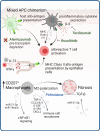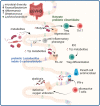Complex interactions of cellular players in chronic Graft-versus-Host Disease
- PMID: 37435079
- PMCID: PMC10332803
- DOI: 10.3389/fimmu.2023.1199422
Complex interactions of cellular players in chronic Graft-versus-Host Disease
Abstract
Chronic Graft-versus-Host Disease is a life-threatening inflammatory condition that affects many patients after allogeneic hematopoietic stem cell transplantation. Although we have made substantial progress in understanding disease pathogenesis and the role of specific immune cell subsets, treatment options are still limited. To date, we lack a global understanding of the interplay between the different cellular players involved, in the affected tissues and at different stages of disease development and progression. In this review we summarize our current knowledge on pathogenic and protective mechanisms elicited by the major involved immune subsets, being T cells, B cells, NK cells and antigen presenting cells, as well as the microbiome, with a special focus on intercellular communication of these cell types via extracellular vesicles as up-and-coming fields in chronic Graft-versus-Host Disease research. Lastly, we discuss the importance of understanding systemic and local aberrant cell communication during disease for defining better biomarkers and therapeutic targets, eventually enabling the design of personalized treatment schemes.
Keywords: GvHD pathogenesis; cell-cell communication; chronic graft-versus-host disease; hematopoietic stem cell transplantation; immune cell networks.
Copyright © 2023 Gail, Schell, Łacina, Strobl, Bolton, Steinbakk Ulriksen, Bogunia-Kubik, Greinix, Crossland, Inngjerdingen and Stary.
Conflict of interest statement
The authors declare that the research was conducted in the absence of any commercial or financial relationships that could be construed as a potential conflict of interest.
Figures





References
-
- Cooke KR, Luznik L, Sarantopoulos S, Hakim FT, Jagasia M, Fowler DH, et al. . The biology of chronic graft-versus-Host disease: A task force report from the national institutes of health consensus development project on criteria for clinical trials in chronic graft-versus-Host disease. Biol Blood Marrow Transplant (2017) 23:211–34. doi: 10.1016/j.bbmt.2016.09.023 - DOI - PMC - PubMed
-
- Lia G, Di Vito C, Bruno S, Tapparo M, Brunello L, Santoro A, et al. . Extracellular vesicles as biomarkers of acute graft-vs.-Host disease after haploidentical stem cell transplantation and post- transplant cyclophosphamide. Front Immunol (2021) 12:816231. doi: 10.3389/fimmu.2021.816231 - DOI - PMC - PubMed
Publication types
MeSH terms
LinkOut - more resources
Full Text Sources

